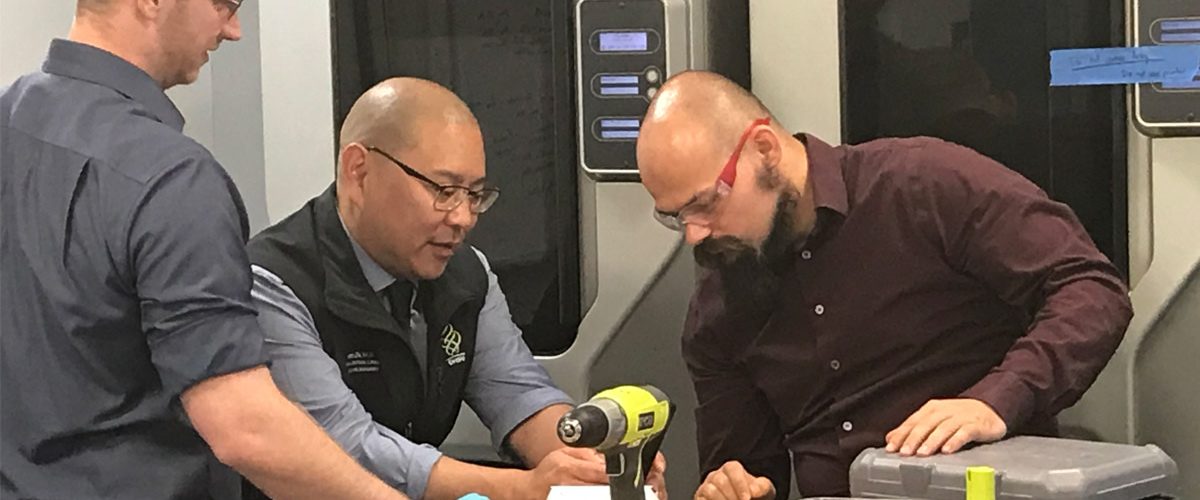A research collaboration and ensuing friendship between a trauma surgeon in Oregon and a handful of engineers in Florida has resulted in a new ventilator design that requires no electricity and could be a game-changer during the COVID-19 pandemic.
Albert Chi, who specializes in critical care and prosthetics, was keeping a close eye on COVID-19 during the early days. He immediately began working with his team at Oregon Health and Science University to develop a new, easy way to replicate ventilators that could be deployed anywhere. As a retired commander of the U.S. Navy Reserve, Chi is well versed in extreme conditions.
When Chi had a design, he called his friend and clinical-trial collaborator Albert Manero ’12 ’14MS ’16PhD, CEO and co-founder of Limbitless Solutions.
Manero leads the nonprofit based at the University of Central Florida. The team creates prosthetics for children and has been conducting a clinical trial with Chi since 2018. Currently the trial is being adapted for telemedicine per FDA guidelines (in response to COVID-19) to mitigate participants’ travel. In the interim, Limbitless pivoted its manufacturing capabilities to produce hundreds of 3D-printed face shield components for local hospitals through a national coalition led by 3D company Stratasys.
“Dr. Chi called me and said, ’Hey Albert, I have an idea,’” Manero says. “When Dr. Chi has an idea, we listen. We were happy to support in any way we could.”
That’s when Manero called Limbitless’ engineers together to tackle this new challenge. Limbitless printed the pieces in its laboratory for the prototype, which exceeded expectations when it was tested in Chi’s lab in Oregon. Within days, OHSU submitted a request to the FDA for Emergency Use Authorization to make the 3D-printed ventilators available to support hospitals worldwide battling high caseloads in hot spots due to the pandemic.
Limbitless this week also produced pieces for the first 10 ventilator prototypes, which Chi says will be sent to hospitals nationwide to test and collect feedback while he awaits FDA approval.
Made by Engineers: How the Ventilators Work
Chi’s ventilator is unique, because it does not require electronics and uses 3D-printed parts, which can be potentially manufactured at hospitals.
Limbitless used printers in its lab at UCF to print the pieces necessary for high quality prints and large-scale distribution. Limbitless key engineers and co-founders, Dominique Courbin ’18 and John Sparkman ’13 ’15MS, optimized the production of the critical pieces at UCF. The pieces fit perfectly when assembled at OHSU. The coordination between the two teams was critical to rapidly prototype the design, Manero says.
Depending on the printer used, a single ventilator could be manufactured within three to eight hours and made operational with the addition of low-cost springs available at any hardware store. The low-tech ventilators can be replicated anywhere in the world for less than $10 of material, Chi says.
Limbitless shipped the first ventilator pieces back to OHSU on April 17. Chi and his team assembled the first prototype and placed it on an oxygen tank to test it. The goal was to see if it would work for at least 24 hours without any durability issues. Chi’s team had already performed extensive modeling and testing in the lab, but the next 24 hours were to determine if OHSU would go after FDA emergency approval.
On April 24, Chi filed with the FDA because the ventilator was still pumping air with no issues 120 hours later.
“Hearing the machine ‘breathing’ during testing was a really moving experience,” Manero says. “The sound is such a reminder of why we continue to do everything we can to support our community in any way we can. It is an example of what teamwork can accomplish to change the world.”
OHSU stopped the durability testing of the first ventilator after seven continuous days with zero issues.
“They did such a good job producing the pieces,” Chi says. “I knew the quality of their work. I knew I could trust them to produce the first 10 prototypes. Our teams are kindred partners just wanting to help save lives. This is the power of heart, mind and a cooperative spirit.”
When the ventilator design is approved, Chi said it would not only help hospitals now, but in the future. The ventilators could be used during another pandemic or in remote regions or after a natural disaster when electricity is scarce.
“I feel like all my experiences until this point — being in the Navy, working in trauma critical care, meeting Limbitless — they all led me here to this moment, where together we can make a difference,” Chi says. “It’s not just about being a doctor, it’s wanting to give back and help anyone in need, which is what I think makes Albert and I such good partners.”
